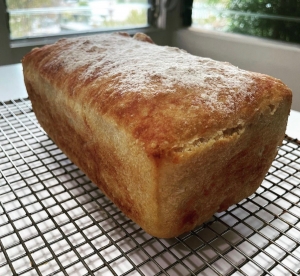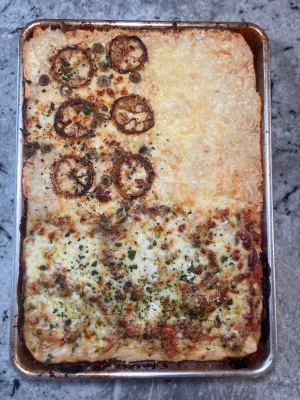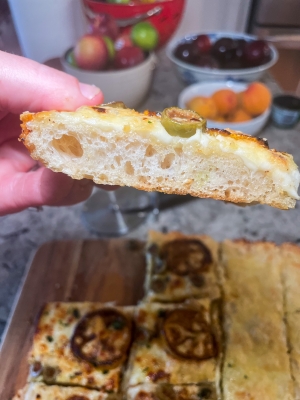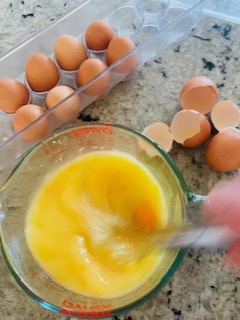curried broccoli stem-cashew soup
- Prep Time 5 minutes
- Cook Time 45-60 minutes
- Estimated Cost $8.50
- 97 Comments

Lunch is an important meal for everyone, but if, like me, you work from home, I think you’ll agree that an enjoyable midday meal is crucial to daily happiness.
This soup, which requires minimal prep, and which is made from scraps most people just toss out (broccoli and cilantro stems), has become a lunchtime staple for me. It’s kind of ugly, to be frank, that I almost didn’t post it, but the more I thought about it, the more I realized it really needs to be out in the world. First of all, it’s very healthy—tons of good fiber and micronutrients from the broccoli, and good fats from the cashews, which also add a bit of dairy-free creaminess and body. It’s also a wonderful, low-effort way to minimize what would otherwise be considered kitchen waste. And finally, it’s objectively delicious. I usually start thinking about it around 10 AM and don’t stop until I sit down for a bowl of it at noon.
The first step is to save your broccoli stems. Sure, you can absolutely roast, sauté or steam them along with the florets when you make broccoli, but this gives you a whole additional meal, plus it saves you the hassle of having to peel the tough exterior off of the stalks. Sometimes, I’ll cut the stems off as soon as I get my broccoli home from the market so they’re ready for this exact purpose.
Then everything just goes into a pot with a little bit of neutral oil, and best of all, you can be seriously sloppy with your chopping because everything is just getting whizzed up in the blender anyway. Get some haphazardly diced onion, a clean but unpeeled piece of ginger (unpopular opnion: you almost never really need to bother peeling it—the peel is unoffensive and way too annoying to remove, and yes, I know about the spoon trick), some garlic, which you smash with the back of a knife but don’t do anything else to (seriously, don’t even bother removing the ends, they’re just goingt o get blitzed into oblivion anyway), and a bit of good curry powder. I’m fond of this one.

Then add the broccoli stems, a handful of raw cashews, and either water or chicken/veg broth.

Give it a good stir, bring the mixture to a boil, then cover and let simmer over medium-low heat for 45 minutes to an hour, until the broccoli is squishably soft.

Then either use an immersian blender or dump the whole thing into a regular blender or food processor. I normally prefer an immersian blender for soups, since it’s so much neater and easier than bothering with transferring hot liquie to an actual vessel, but when I use cashews as a thickener, as I am here, I like to go with the big guns to ensure ultimate smoothness.

Season with sriracha and salt, then add the stems of one bunch of cilantro. No worries if they’ve seen better days. Again, we’re blending everything up.

The result is, perhaps, not the single most gorgeous soup I’ve ever made, but boy is it good.

Depending on the size of the broccoli stems, I’m usually able to get about 3-4 small servings out of this recipe, or two large ones, if I’m serving it as an entree. Lately, I’ve been eating a cup of it with an English muffin topped with chicken salad, but it goes with just about any sandwich, salad, toast, wrap, or even leftover rice.

Depending on what I have on hand, I’ll sometimes swap in other veggies, or add them to the broccoli stems. It’s a great way to put anything aging or overgrown out of its misery. Think of it as kind of a home for wayward produce. The soup works nicely with carrots (just scrub them and chop roughly—no need to peel), cauliflower (you might need the cores/stems from a few heads of cauli to have enough to make soup), zucchini (especially when your garden is overflowing with it), and asparagus (ideal for those woody, overgrown asparagus bunches which seem destined for the bin). Whatever you’ve got, it’ll be good.
Ingredients
- neutral oil, such as canola, vegetable, or avocado pantry
- 1 medium white or yellow onion, chopped roughly $1.50
- 1 1-inch piece ginger, scrubbed and chopped roughly pantry
- 3 cloves garlic, smashed with the side of a knife pantry
- 1 1/2 teaspoons curry powder pantry
- stems from one large bunch of broccoli (about 5 long stems, florets removed) $3
- 1/8 cup raw cashews $2.50 in the bulk aisle
- 3 cups water or chicken/vegetable broth
- sriracha to taste (I used about a tablespoon) pantry
- 1/2-3/4 teaspoon salt, depending on salinity of liquid used pantry
- stems from one bunch of fresh cilantro, plus a few leaves for garnish $1.50
Recipe Serves 2-4
Directions
- Heat the oil over medium heat in a heavy-bottomed soup pot.
- Add the chopped onion and let cook until translucent.
- Add the ginger, garlic, and curry powder, and let cook for 2-3 minutes, stirring occasionally, until very fragrant. Turn down the heat if it starts to smoke or scorch.
- Add the cashews and water or broth, and cover.
- Let simmer on medium-low for 45 minutes-1 hour, until the broccoli is very soft.
- Puree, either with an immersian/stick blender, or in a food processor or blender, until very smooth. Let the machine run for a little longer than seems necessary. You want the cashews to fully break down.
- Taste, then add sriracha and salt as needed, as well as sriracha stems.
- Puree again, just until the cilantro breaks down. The soup should have tiny green flecks.
- Serve hot, garnished with cilantro leaves if desired.












































